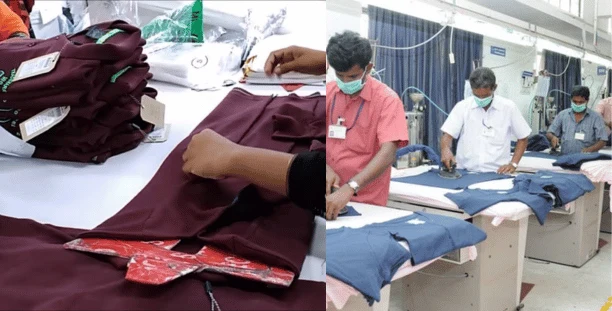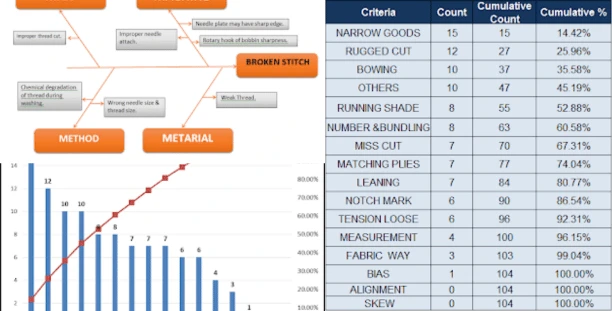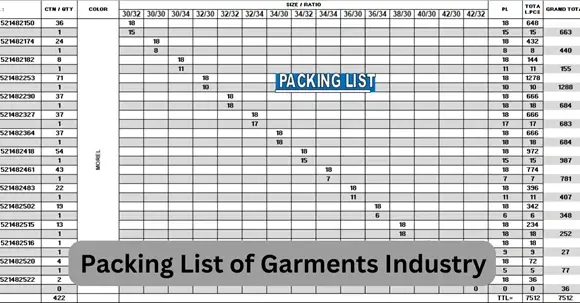AQL Chart for Sampling & Acceptance Level in Garments Quality Inspection
AQL is an acceptable quality limit or acceptable quality level (AQL), a sampling of quality audits or inspection systems used for quality audits or inspection processes in the Garment industry. AQL sampling quantity and acceptance level information is shown in an AQL chart, and QC is used in quality audits when a 100% quality inspection is not possible. This article presents an AQL Chart for Sampling & Acceptance Level in Garments Quality Inspection.

AQL inspection is used in fabric roll sampling, trims inspection, cutting panel inspection, Sewing, Finishing, and Final Inspection. Though there is 100% inspection also available in sewing and finishing AQL audit is done for checking the quality control process. There are various types of AQL sampling plans in the world, I gave the most commonly used 3 types of AQL charts. Classification of garments defects is Major, minor, and critical; major and minor defects count under the AQL limit.
Uses of AQL Audit in the Garments Industry
- Fabric roll sampling for inspection
- Trims and Accessories inspection
- Cutting panel inspection
- Sewing Quality Control Audit before moving to the next inspection.
- Finishing Quality Audit
- Finishing the inline inspection
- Pre-final Inspection
- Final inspection process in the Garments Industry
- Customer Quality inspection after receiving goods.
- Finishing Quality inspection in Sweater Manufacturing.
AQL Chart for Sampling and Acceptance Level
| General inspection levels | Special inspection levels | ||||||
| Lot size | I | II | III | S1 | S2 | S3 | S4 |
| 2-8 | A | A | B | A | A | A | A |
| 9-15 | A | B | C | A | A | A | A |
| 16-25 | B | C | D | A | A | B | B |
| 26-50 | C | D | E | A | B | B | C |
| 51-90 | C | E | F | B | B | C | C |
| 91-150 | D | F | G | B | B | C | D |
| 151-280 | E | G | H | B | C | D | E |
| 281-500 | F | H | J | B | C | D | E |
| 501-1200 | G | J | K | C | C | E | F |
| 1201-3200 | H | K | L | C | D | E | G |
| 3201-10000 | J | L | M | C | D | F | G |
| 10001-35000 | K | M | N | C | D | F | H |
| 35001-150000 | L | N | P | D | E | G | J |
| 150001-500000 | M | P | Q | D | E | G | J |
| 500001-over | N | Q | R | D | E | H | K |
| Sample | Sample | 0.065 | 0.10 | 0.15 | 0.25 | 0.40 | 0.65 | 1.0 | 1.5 | 2.5 | 4.0 | 6.5 | |||||||||||
| code letter | size | ac | re | ac | re | ac | re | ac | re | ac | re | ac | re | ac | re | ac | re | ac | re | ac | re | ac | re |
| A | 2 | L | L | K | K | J | J | H | H | G | G | F | F | E | E | D | D | C | C | B | B | 0 | 1 |
| B | 3 | L | L | K | K | J | J | H | H | G | G | F | F | E | E | D | D | C | C | 0 | 1 | A | A |
| C | 5 | L | L | K | K | J | J | H | H | G | G | F | F | E | E | D | D | 0 | 1 | B | B | D | D |
| D | 8 | L | L | K | K | J | J | H | H | G | G | F | F | E | E | 0 | 1 | C | C | E | E | 1 | 2 |
| E | 13 | L | L | K | K | J | J | H | H | G | G | F | F | 0 | 1 | D | D | F | F | 1 | 2 | 2 | 3 |
| F | 20 | L | L | K | K | J | J | H | H | G | G | 0 | 1 | E | E | G | G | 1 | 2 | 2 | 3 | 3 | 4 |
| G | 32 | L | L | K | K | J | J | H | H | 0 | 1 | F | F | H | H | 1 | 2 | 2 | 3 | 3 | 4 | 5 | 6 |
| H | 50 | L | L | K | K | J | J | 0 | 1 | G | G | J | J | 1 | 2 | 2 | 3 | 3 | 4 | 5 | 6 | 7 | 8 |
| J | 80 | L | L | K | K | 0 | 1 | H | H | K | K | 1 | 2 | 2 | 3 | 3 | 4 | 5 | 6 | 7 | 8 | 10 | 11 |
| K | 125 | L | L | 0 | 1 | J | J | L | L | 1 | 2 | 2 | 3 | 3 | 4 | 5 | 6 | 7 | 8 | 10 | 11 | 14 | 15 |
| L | 200 | 0 | 1 | K | K | M | M | 1 | 2 | 2 | 3 | 3 | 4 | 5 | 6 | 7 | 8 | 10 | 11 | 14 | 15 | 21 | 22 |
| M | 315 | L | L | N | N | 1 | 2 | 2 | 3 | 3 | 4 | 5 | 6 | 7 | 8 | 10 | 11 | 14 | 15 | 21 | 22 | L | L |
| N | 500 | P | P | 1 | 2 | 2 | 3 | 3 | 4 | 5 | 6 | 7 | 8 | 10 | 11 | 14 | 15 | 21 | 22 | M | M | L | L |
| P | 800 | 1 | 2 | 2 | 3 | 3 | 4 | 5 | 6 | 7 | 8 | 10 | 11 | 14 | 15 | 21 | 22 | N | N | M | M | L | L |
| Q | 1250 | 2 | 3 | 3 | 4 | 5 | 6 | 7 | 8 | 10 | 11 | 14 | 15 | 21 | 22 | P | P | N | N | M | M | L | L |
| R | 2000 | 3 | 4 | 5 | 6 | 7 | 8 | 10 | 11 | 14 | 25 | 21 | 22 | Q | Q | P | P | N | N | M | M | L | L |
The AQL chart is needed in the garment industry to do a quality inspection, lot by lot, AQL Audit. Generally, AQL chart sampling levels are like 1.0, 1.5, 2.5, and 4.0.
AQL chart for Garments inspection
AQL-4.0 in the Garments Industry
As per the above AQL chart, if the lot size is 4000, then the sampling size will be 80 pieces as per sampling level (I). As per the acceptance level 2.5, Acceptance Major defects quantity 5 or less, then the lot will be passed, or more than 5 defects will be failed or rejected in the Audit.
AQL-2.5 in the Garments Industry
1. Suppose we follow acceptance AQL level 2.5 for major defects. As per the above AQL chart, if the lot size is 4000, then the audit quantity will be 80 pcs. Major defects quantity among audit quantity 5 or less than 5 will be passed, or more than 5 defects will be failed or rejected in the Audit.
2. Suppose we follow acceptance AQL level 2.5 for major defects. As per the above AQL chart, if the lot size is 12500, then the audit quantity will be 125 pcs. Major defects quantity among audit quantity 7 or less than 7 will be passed, or more than 7 defects will be failed or rejected in the Audit.
AQL-1.5 in the Garments Industry
Suppose we follow acceptance AQL level AQL 1.5 for major defects. As per the above AQL chart, if the lot size is 4000, then the audit quantity will be 80 pcs. Major defects quantity among audit quantity 2 or less than 2 will be passed, or more than 2 defects will be failed or rejected in the Audit.
AQL Audit system in the Garments industry
First of all, check the lot quantity. As per AQL Audit requirement, the auditor picks an audit/ sample quantity randomly from every lot, like a lottery. The auditor checks garments from the picked sample quantity and counts defects. If the defective quantity exceeds the acceptable limit, the audit result is “failed” or “rejected” for the inspected lot.
Why do we need an AQL Audit in the Garments Industry?
When you want to check quality inspected goods, or you do not have time to check 100% of goods, you can do an AQL audit. A final inspection is done in AQL Audit; factories have an internal AQL audit system. To check the supplier’s fabrics and trim quality, you need an AQL audit of the supplier’s Raw materials. Sewing end line and operator bundle-wise AQL audit is also done in the apparel industry.



